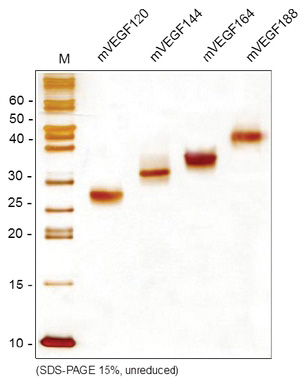VEGF-A (VEGF164) Mouse Protein
Other products for "Vegfa"
Specifications
| Product Data | |
| Species | Mouse |
| Expression Host | E. coli |
| Expression cDNA Clone or AA Sequence |
APTTEGEQKS HEVIKFMDVY QRSYCRPIET LVDIFQEYPD EIEYIFKPSC VPLMRCAGCC NDEALECVPT SESNITMQIM RIKPHQSQHI GEMSFLQHSR CECRPKKDRT KPENHCEPCS ERRKHLFQDP QTCKCSCKNT DSRCKARQLE LNERTCRCDK PRR
|
| Predicted MW | 38.4 kDa |
| Purity | >95% by SDS-PAGE and silver stain |
| Presentation | Purified |
| Buffer | Presentation State: Purified State: Lyophilized protein Buffer System: 50 mM Acetic Acid Stabilizer: None |
| Bioactivity | Biological: The ED50 for stimulation of cell proliferation by human umbilical vein endothelial cells for VEGF164 has been determined to be in the range of 1-5 ng/ml. |
| Endotoxin | < 0.1 ng/µg of VEGF164 |
| Reconstitution | The lyophilized VEGF164 is soluble in water and most aqueous buffers. The lyophilized VEGF164 should be reconstituted in PBS or medium containing at least 0.1% human or bovine serum albumin to a concentration not lower than 50μg/ml. |
| Preparation | Lyophilized protein |
| Protein Description | Recombinant Mouse Vascular Endothelial Growth Factor164 |
| Note | Protein RefSeq: NP 001020421 mRNA RefSeq: NM 001025250 |
| Storage | Store (following reconstitution in aliquots) at -20°C or below. Avoid repeated freezing and thawing. |
| Stability | Shelf life: one year from despatch. |
| Reference Data | |
| RefSeq | NP_001020421 |
| Locus ID | 22339 |
| UniProt ID | Q00731, A0A1L1SVG2 |
| Cytogenetics | 17 22.79 cM |
| Synonyms | V; Veg; Vegf; VEGF12; VEGF16; VEGF18; Vpf |
| Summary | This gene is a member of the PDGF/VEGF growth factor family. It encodes a heparin-binding protein, which exists as a disulfide-linked homodimer. This growth factor induces proliferation and migration of vascular endothelial cells, and is essential for both physiological and pathological angiogenesis. Disruption of this gene in mice resulted in abnormal embryonic blood vessel formation. This gene is upregulated in many known tumors and its expression is correlated with tumor stage and progression. Alternatively spliced transcript variants encoding different isoforms have been found for this gene. There is also evidence for alternative translation initiation from upstream non-AUG (CUG) codons resulting in additional isoforms. A recent study showed that a C-terminally extended isoform is produced by use of an alternative in-frame translation termination codon via a stop codon readthrough mechanism, and that this isoform is antiangiogenic. Expression of some isoforms derived from the AUG start codon is regulated by a small upstream open reading frame, which is located within an internal ribosome entry site.[provided by RefSeq, Nov 2015] |
Documents
| FAQs |
| SDS |
Resources
Recombinant Protein Resources |
{0} Product Review(s)
0 Product Review(s)
Submit review
Be the first one to submit a review
Product Citations
*Delivery time may vary from web posted schedule. Occasional delays may occur due to unforeseen
complexities in the preparation of your product. International customers may expect an additional 1-2 weeks
in shipping.






























































































































































































































































 Germany
Germany
 Japan
Japan
 United Kingdom
United Kingdom
 China
China
